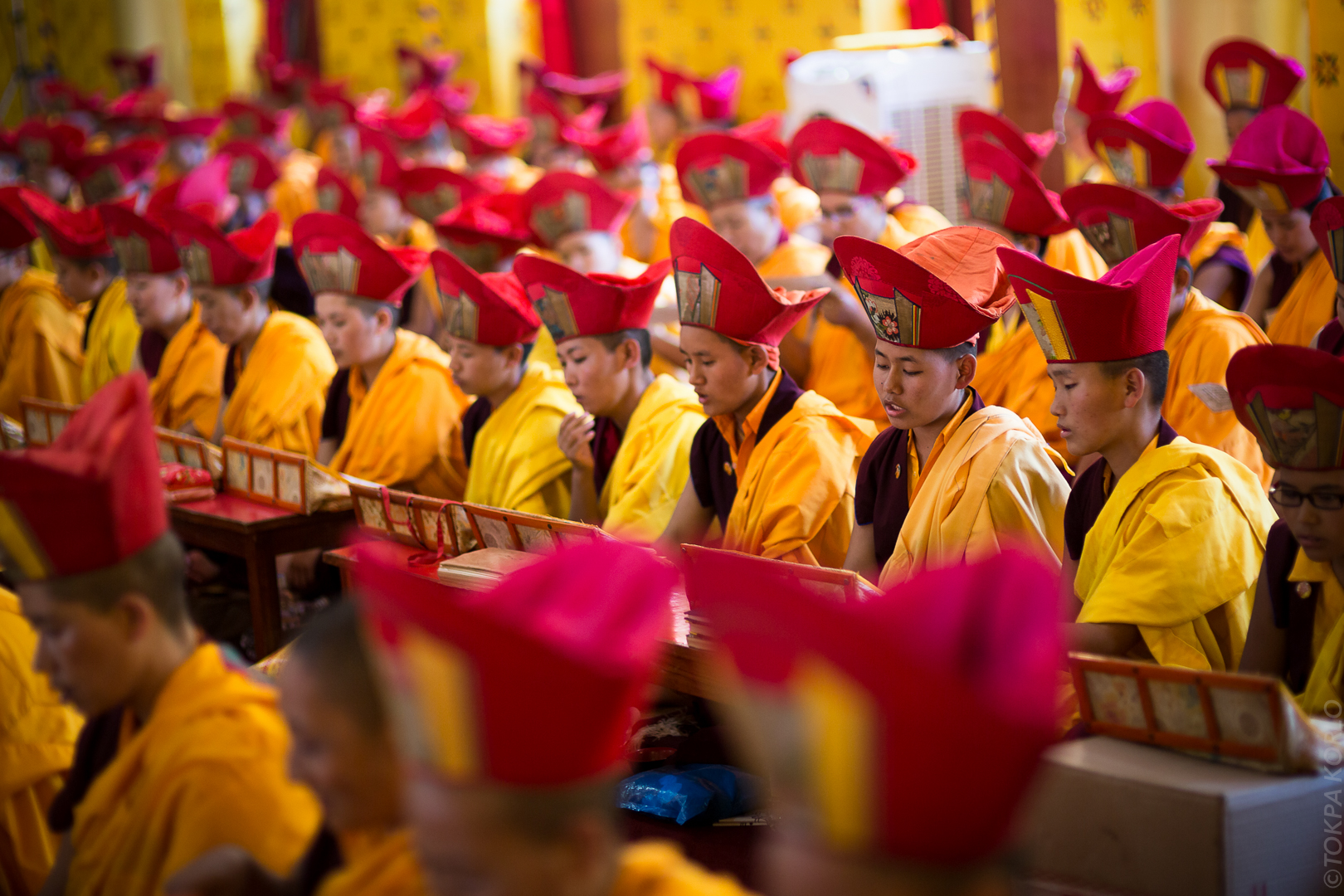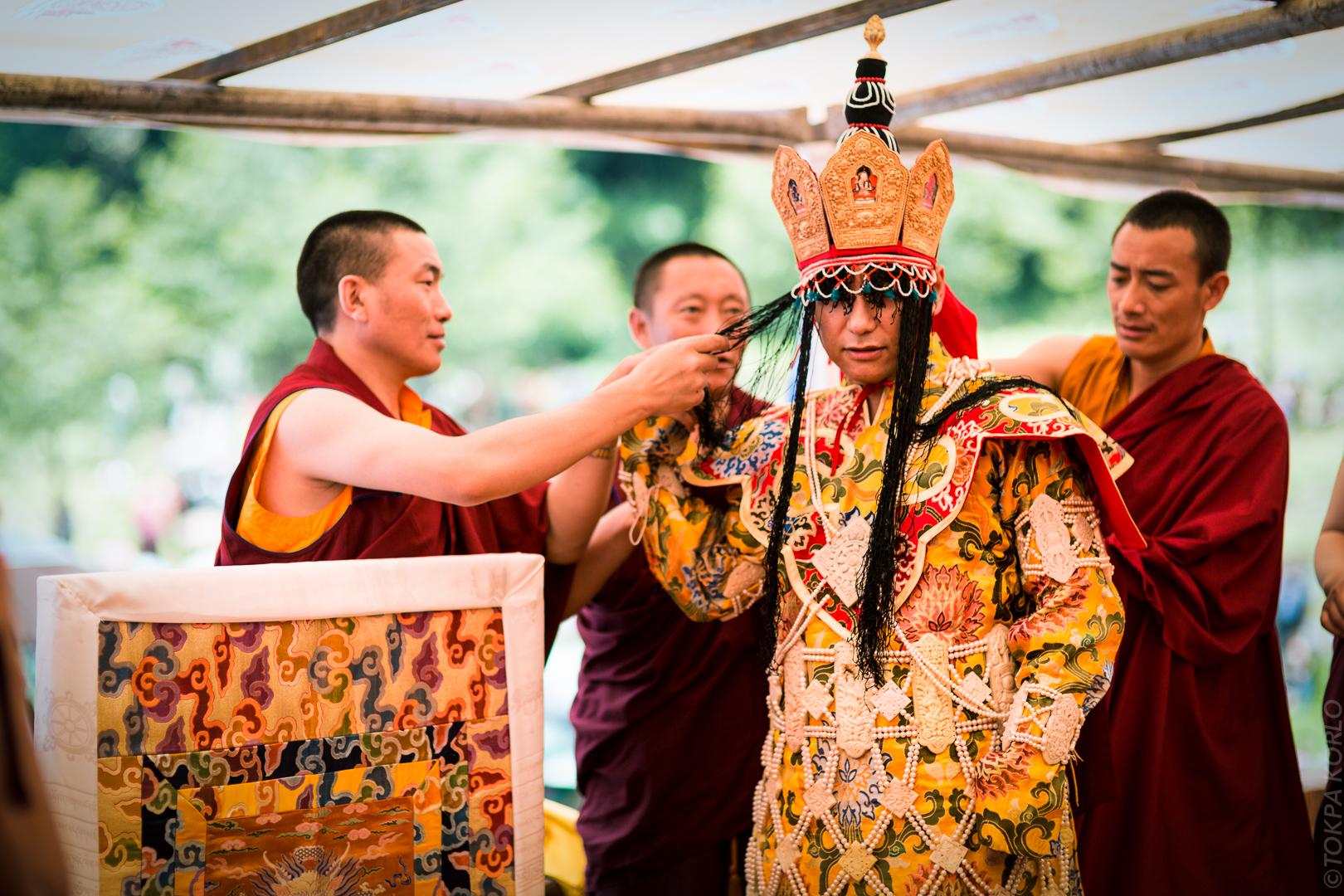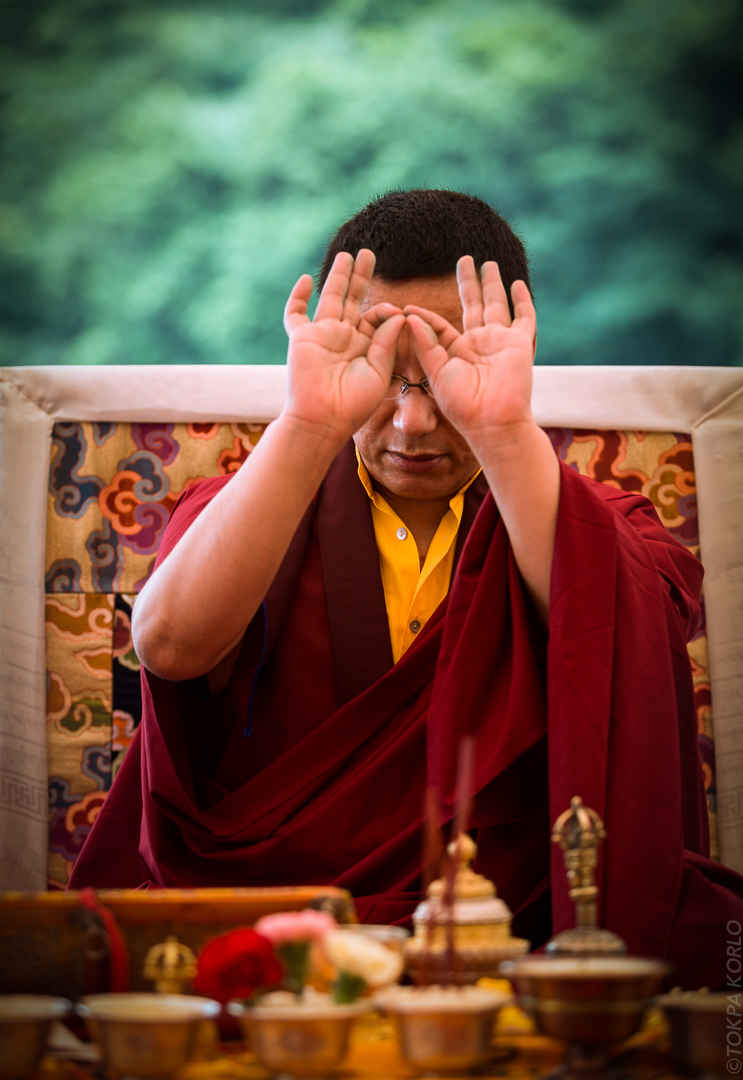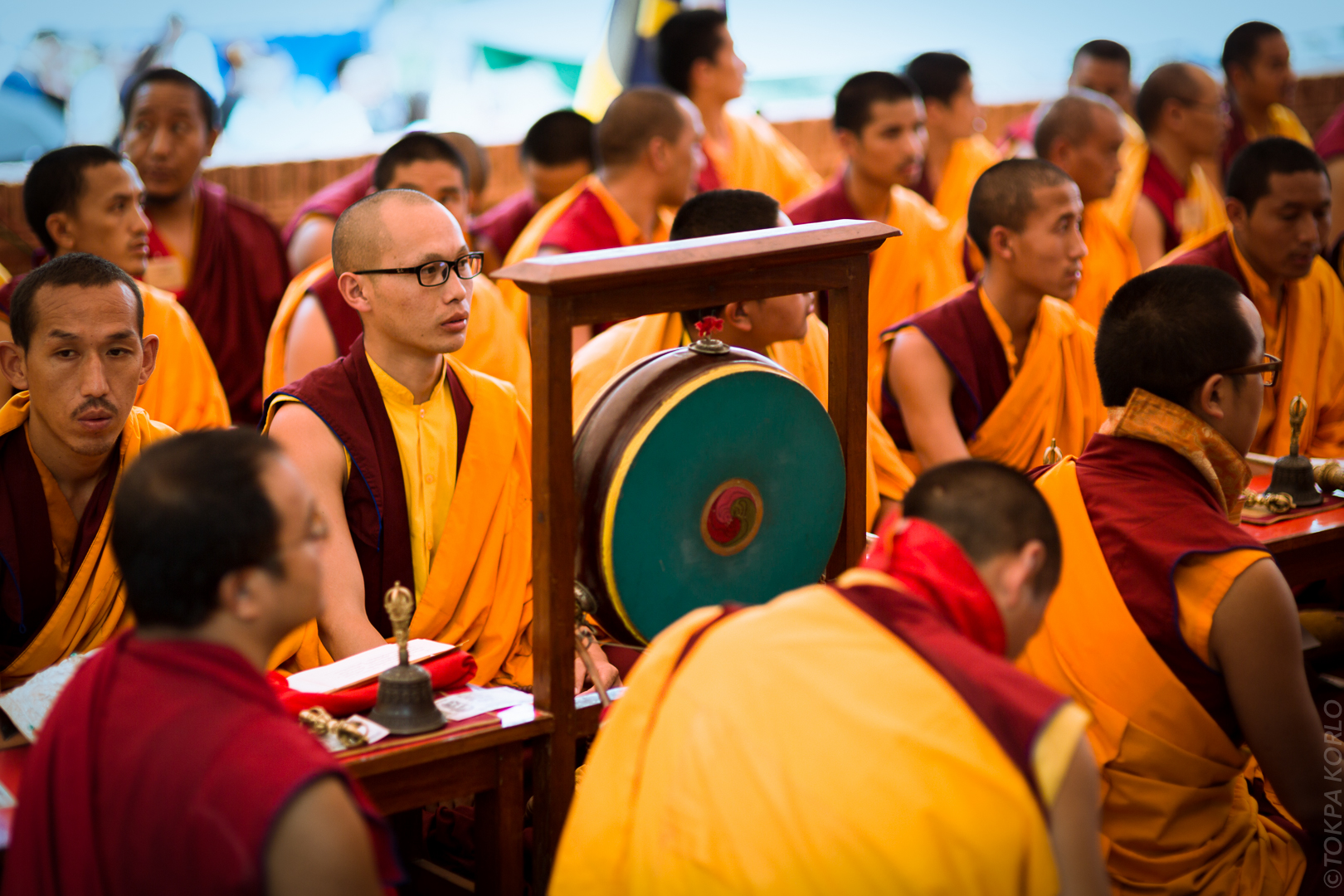Meditation is an extremely profound practice, and it becomes more and more so as one progresses. My advice to everyone is to start out simply – as simply as possible. Honestly, however, I must tell you that I feel inadequate to undertake the task of conveying the true experience of even the most fundamental form of meditation through the limited medium of language. The terminology of any language, by virtue of the fact that it is a human invention, is based solely on common experience, and philosophical language in particular is confined within the boundaries of shared inner experience, with no external reference point to agree upon. Language, in and of itself, is incapable of transcending personal experience, and this is the root of the dilemma we face. If, for example, you touch a cup of hot tea the sensation of heat is felt, and likewise, a sensation of coldness will be felt if you touch an ice cube. Thus the terms hot and cold have a fairly precise meaning which everyone can agree upon, because everyone has experienced these sensations through direct physical contact at one time or another. But how are we to verify our mutual acceptance of terms used to communicate ineffable experiences, such as states of awareness arising in meditation?
While it is true that over the preceding centuries a philosophical language has arisen in Tibet consisting of various dharma terms invented by meditators, understanding the actual meaning of the terms requires a substantial background of information and familiar experiences. It is said, for example, that in the practice of Mahamudra, the experience of Rojik, which translates roughly as ‘one taste’ arises. (Mahamudra literally means ‘Great Seal Meditation’ – in the sense that it is like a fixed stamp sealing a document with melted wax; it is unchanging; the meaning is that after things are perceived evenly.). It is one of many levels of accomplishment which can be attained through Mahamudra practice. It is difficult to pinpoint exactly what the term Rojik is referring to. The word ‘taste’ is only an analogy for a kind of mental experience; it is not the taste experienced by the tongue. A person who has experienced the awareness of one taste can communicate with someone else who has had the same experience by using this word, but the term must remain abstract and ungraspable to those who have yet to experience it. As indicated by this example, dharma terminology may function as a nearly perfect means of communication between two beings who share the same realization of meditative insight, but in general use it tends to become vague and obtuse, capable of providing only a rough outline of the intended meaning.
However, notwithstanding my views on the nature of language, I will attempt to share my thoughts on meditation. As stated earlier, the most profound meditation begins with simple meditation. Calm abiding meditation (T: Shinnay, S: Shamatha) is a very effective technique, and is refreshing and uncomplicated to . Many different methods exist, and all have the same underlying purpose: to enable the mind to remain peacefully and uninterruptedly in a stable state of one-pointed concentration over an extended period of time. One begins by learning to sit still for periods of ten, twenty or thirty minutes, gradually extending the duration of one’s meditation sessions. The ability to remain in a state of complete absorption is considered to be extremely advanced, but even in the early stages of meditation one can learn to sit quietly and be aware of one’s mind, observing the flow of arising and passing thoughts which are like the movement of fleeting clouds in a clear sky.
At first the meditator’s mind is like a wild horse, and by engaging in the consistent practice of calm abiding meditation, it can gradually become tame. Eventually the mind will become clear and completely free of agitation. The activity of mind, which at first is a cascading waterfall, later becomes the gently flowing currents of a broad river and finally becomes the still water of a clear mountain lake.
In order to lay the foundation for developing the concentration abilities which are at the heart of calm abiding meditation, we should begin by exploring the nature of distraction to determine what it consists of and how it arises. There are two main categories of distraction: inner and outer. Outer distraction refers to disturbances in the physical environment, such as sounds, which disrupt concentration. Sometimes distraction can occur without one even noticing it. It is easy to become absorbed in following all kinds of thoughts, thus becoming involved in outer experiences without being consciously aware that this is occurring. At first it is difficult to keep one’s attention from wandering, but slowly, in progressive stages, external distracting influences are overcome. Sometimes, to further enhance discipline in meditation, advanced practitioners utilize additional techniques such as balancing a full glass of water on their heads. Inner distraction can take many forms, some apparently positive and some seemingly negative. Negative distractions include all types of obscuring emotional states, such as anger, jealousy and fear. Actually, it is possible for intense emotions to seem to be magnified by meditation practice into even more strongly overwhelming feelings. This happens due to the fact that in ordinary life the mind is usually jumping about here and there in a random, hectic motion, chattering on and on endlessly preoccupied with one mental activity after another, so that emotional states tend not to be noticed deeply. But in the empty space of quietly absorbed mind, the obsessive strength of emotional patterns becomes acutely obvious.
Inner distractions involving positive feelings are more subtle and deceptive. They occur as wonderful, pleasant frames of mind resulting from successful accomplishments in the practice of calm abiding meditation, and are characterized by a tremendous feeling of contentment, comfort, and a sense of happiness and well being. The difficulty is that it is quite probable that the meditator will become attached to these states of mind, and will strive to bring about their repeated manifestation in an attempt to maintain a lasting feeling of joyous abandonment. Attachment thereby turns into a hindrance, which forestalls one’s advancement into further stages of awareness.
In the absence of inner and outer distractions, a sense of well being, clarity and an intuitive appreciation of emptiness will spontaneously arise. However, if at this moment, with our ordinary way of thinking, we were to pause and gaze at a teacup resting on a table in front of us, we would not feel these pristine qualities of mind arising. Even if we were able to maintain a state of attentive awareness while focusing on an object, it would be like holding a wild pony on the end of a lasso. But, as one progresses in meditation, the mind becomes more and more tame, and eventually the object of focus is shifted to the self; this results in an experience of expansive well being, clarity and a vast pervasive sense of emptiness, which is characterized by the absence of ordinary conceptual habits of conceiving of phenomena as substantially real and arisen from an inherent self nature. At this stage a teacher, or guide, is indispensable. On one’s own it is difficult to recognize and correctly interpret what is occurring, since one is immersed in the experience and cannot discern on one’s own if it is genuine or if it is intentionally fabricated by subtle mental inclinations arising from preconceived expectations. Not being able to perceive the subtle workings of the mind, one would naturally, on one’s own, assume that the experience is uncontrived. Only someone who is familiar with all the stages of meditative practice will be able to see clearly what is really going on. In choosing a teacher, consider that he/she should be capable, mature and patient, and able to be direct and skilful without being harsh or discouraging to the aspiring student. I cannot overemphasize the importance of finding such a teacher.
So, as we have seen, the arising of an authentic sense of well being, emptiness and clarity is an indication of having successfully accomplished calm abiding meditation. This, in turn, will naturally give rise to an increasing ability to abide one pointedly in these experiences. For example, if an experience of well being arises, and a one-pointed focus in that experience develops, then it will eventually become stable and lasting. However, the dualistic nature of human thought inhibits the actualization of a pure unbiased sense of well being because the mind tends to create this sort of feeling in order to counteract uncomfortable and disturbing thoughts, and therefore the sense of joyfulness experienced might simply be an artificial invention – a mere mental projection based on expectation rather than a valid, naturally arising perception.
This is likewise true for the experience of clarity, which can also easily become distorted. Before we look into this, however, let us first define clarity. Clarity of mind is nothing other than awareness aware of itself. Sometimes it is spoken of as a clear light presence, which refers to its quality of vivid, lucid awareness; it has the ability to illuminate only in the sense of making what is unknown known, and does not literally give off light in the way a street lamp does. It is just a manner of speaking.
In ordinary, everyday life we are unaware of the essential nature of mind. The underlying clear light nature of mind is normally obscured by the sea of thoughts that arise due to stimulation of the physical and mental aspects of sensory awareness as a result of the presence of secondary supportive conditions, such as the interaction between outer phenomenal appearances and the sense faculties, as well as the connective process which transmits sensory input into mental sense perceptions. This ordinary, preoccupied state of mind is actually a kind of stupor, or drowsiness, and is based on the befuddled ignorance of dense mental states in which self awareness is lacking. It is an automatically occurring continuous series of cognitive actions and reactions which take place without relying on the self-reflective, self-aware aspect of consciousness.
In short, the reflective capacity of the mind is the basis of true intelligence, and all superfluous mental activity which proceeds forth without being connected with the pervasive, even ultimate, self awareness of conscious mind, is simply ignorant mental activity – a kind of noise which serves to distract mind from its true nature. Once the thought process has been pacified, immense clarity results. As was mentioned earlier, if attachment to the feeling of clarity arises, it creates an artificial state of mind, which detracts from the actual experience of clarity, and one is left again with an ordinary, samsaric state of mind. What holds true for well-being and clarity also applies to emptiness. The nature of mind as emptiness is normally not experienced due to ignorance. When the mind is viewed as solid and intrinsically real, tension and neurosis are inevitable, and consequently are mistakenly seen as truly existent. Once conceptual thoughts are pacified, the ground is cleared for an authentic realization of emptiness to take place. However, as was the case with joy and clarity, it is imperative that the wish to recreate, prolong and possess that state be relinquished so that perception can remain untainted and therefore reliable.
In summary, it can be stated that practicing calm abiding meditation is the cause for achieving equanimity and peace. In a state of calmness the mind is capable of a clear focus in which it is aware of its profound nature as joyous well being, clarity and emptiness, without imposing the mistaken concept of truly substantial, inherent existence on mind itself. With continuous practice the potential for these capacities to increase is limitless, and finally, one enters a state of illumination. It is like a caterpillar emerging from the cocoon as a butterfly. The consciousness of a person at this level of awareness is totally detached from any worldly concerns or selfish interests, and he/she is solely concerned with the further development of meditative concentration, although of course it is still necessary to eat in order to maintain the body. However, as great as such meditation states may be, they do not transcend samsaric existence, and do not bring about ultimate liberation. They are not comparable to a Buddha’s enlightenment.
In order to obtain the broad awareness which characterizes the enlightened state, as well as to obtain freedom from samsaric states of awareness, it is crucial that the practice of calm abiding meditation be conjoined with superior insight meditation (T. Ihagtong, S: vipashyana), which is also sometimes termed analytical meditation. Having already increased the mind’s ability to focus clearly through calm, abiding meditation, superior insight meditation comes very easily and naturally. Although many people speak quite casually about vipashyana as a form of meditation often employed even by beginning meditators of various traditions, in this case the term is used in a very specific way. Actually, the same term can be used to describe two different levels of practice. Here it refers to a rather advanced practice, and at its highest stage it is inseparable from the awareness of a Buddha. So it is not common at all. Within the context of tantric Buddhist philosophy, even the highly evolved intuitive reasoning of the Madhyamaka, and other schools of thought, are categorized as types of superior insight meditation. In general although they am interrelated, calm abiding meditation is usually referred to as the development phase, and superior insight is the completion phase; and so, in its fruition it is considered a very advanced form of meditation.
As beginners we must analyze our present state of mind and realize that it is deluded. Through logical investigation we must discover the cause of mental confusion. Our search will inevitably lead us to the insight that both inner and outer phenomena (mental sensations and objects of sense perception) are insubstantial and unreal.
It is best to begin analytical meditation by observing the nature of outer phenomena and then gradually proceeding to more and more subtle aspects of mind itself, because this second aspect, though less obvious, is a more relevant consideration for meditation practice. Through logical inquiry we can see that all outer objects which seem to truly exist are merely manifestations of confused states of mind, and do not exist as we ordinarily think they do. Actually, they are merely mental projections. It is for this reason that, in Mahayana Buddhism, understanding the nature of cause and effect as it is observed in the outer world, is the foundation upon which other philosophical views are based.
Once the nature of these mental projections is understood, it is possible to reverse the mental process which creates the seemingly solid constraints of ordinary reality, and in this way it is possible to transcend ordinary states of mind which are controlled by confusion. Our present experience, relegated to the context of relative reality, leads us to see the passing mental events, or in other words, external phenomena, as substantially real when in fact their nature is illusory, like images in a dream. It is for this reason that we are controlled by these illusions. By meditating we can eventually overcome this tendency as mind realises its own nature more and more. Gradually, the externally manifesting illusion comes under conscious control, and even serves as an enhancement to meditation practice. Bodhisattvas, beings who have realised the nature of emptiness, and who have successfully cultivated perfect compassion for all beings, are able to utilise, and even transform, illusory reality in order to spontaneously fulfil the needs of sentient beings, and further more, are able to manifest simultaneously in various realms in order to guide them. Buddha Amitabha, for example, manifests in the Buddha realm of Dewachen, while simultaneously manifesting Wherever else it is appropriate for him to do so. This is possible because he is able to control reality. He is like a doctor who is able to cure every malady with exactly the right medicine.
The level of mastery of a Buddha such as Amitabha is quite great, but even at much earlier stages, great abilities can manifest. A practitioner who has mastered the six yogas of Naropa will be able to engage in the practice of conscious dreaming. Being able to maintain awareness in a dream state leads to the ability to manipulate the causal forces in a dream, which are not strongly fixed. With practice, they can be controlled by mind. A greatly accomplished practitioner is able to expand this awareness and relate the same principle to causal forces in daily life. It is for this reason that first and second level Bodhisattvas, having achieved the ability to manifest freely, are able to greatly benefit beings, although not as extensively as Buddhas. The main objective of all such practices is to perceive the essence of mind as it truly is. Even a glimpse of this essence is in to restoring sight to a blind person. Perception of the mind’s true nature becomes more and more accurate as the practice becomes more familiar. Therefore, it is beneficial to utilise analytical meditation in order to arrive at a conceptual approximation of mind’s intrinsic nature, which will later be revised through direct experience.
Analysis begins with very basic observations. For example, we see that mind is not of a physical nature in that it has qualities other than those which are ascribed to the brain which can be viewed and touched. But it is not nothing. It is a living presence that is vivid and dynamic. Mind’s actual nature is clear, empty and unobstructed. In addition, we can divide mind into two aspects, the first being the state that we are conscious of, which is the continuous flow of arising and ceasing thoughts, each distinct from the last.
Try to count the number of thoughts that occur in sixty seconds. You can see that many thoughts arise and pass on. Thoughts are not solid entities, and it is not possible to halt the arising and ceasing of thoughts. Try also to count the colors you see before you this instant. The mind catches each color distinctly even though it does not specifically focus on each one. Each color is the cause of a new thought arising. So, if all thoughts are eliminated, what’s left?
What’s left is the second aspect of mind – that which focuses on itself rather than on outer objects. Nothing will be seen, heard, tasted, smelled or felt through sense consciousness when this happens, and awareness will be completely released from all confinement. Following this, the range of mental vision, hearing and so on become vastly greater than before, and thus the five higher types of conscious sense perception will occur.
Someone who is new to meditation, by beginning with a basic practice that places emphasis on being aware of the self has the potential to progress along the stages recounted here. Eventually, as the ability to focus one-pointedly without contrived effort develops, disturbing emotions such as pride and jealousy can be analysed. As a result, outer objects of focus become inner objects of focus. The actual root of clinging to reality as truly existent cannot be uprooted until a very advanced level of superior insight meditation is attained, but it is still possible for conflicting emotions to be at least partially subdued much earlier.
Even at first, the practice of calm abiding meditation smooths out emotional obstacles in one’s life by allowing one to clearly see each emotion as it arises, and therefore to understand that it doesn’t truly exist in that it is merely a mental event. If the mind is able to realise the emptiness of emotions then they don’t exist. Even attachment will sub side when recognized as empty. Karma, on the other hand, continues to function as the unceasing flow of cause and effect. Calm abiding meditation on its own does not have the power to release the meditator from the necessity of being subject to the process of cause and effect. Discipline in daily life, such as the regulation of food intake, also helps in decreasing the impact of frustrating experiences on the mind’s balance. By the time a level of attainment that allows one to engage in superior insight meditation is achieved, disturbances relating to karmic effects do not intrude much. However, at the level of calm abiding meditation practice, it is still relatively easy to become disturbed. What to do about it?
One recommendation I have is to take the vows of a Bodhisattva, which entail a far-reaching commitment to subsume one’s personal desire for enlightenment under the greater goal of aiding all beings. By making such a commitment now one sows the seeds for one’s future development so that one’s strong and sincere wish to free all beings from the suffering of samsara. It is beneficial to recall to mind that all beings without exception are our relatives, because at some time or another during past existences, they have been our fathers and mothers, and have shown us immeasurable kindness. Holding this sort sincere wish to free all beings from the suffering of samsara. It is beneficial to recall to mind that all beings without exception are our relatives, because at some time or another during past existences, they have been our fathers and mothers, and have shown us immeasurable kindness. Holding this sort of view completely transforms one’s practice as well, because if the personal motivation of striving for one’s own liberation is altered out of compassion, then actually this is the shortest and most direct way of attaining enlightenment. Why? Because from -the very beginning this motivation puts the focus of one’s thought in line with that of the Buddha.
In taking the Bodhisattva vows, one promises to follow the guidelines of proper conduct associated with a Bodhisattva’s lifestyle. The vows relate not only to one’s outer activity, but also to one’s inner attitude. If the vow is maintained carefully and never allowed to deteriorate, the immense power generated by holding this vow will subdue all kinds of potential emotional disturbances and disruptions to one’s practice. As Shantideva said in A Bodhisattva’s Way of Life, “Taking this vow protects one from all types of hindrances.” It is therefore necessary to make continuous efforts to maintain this vow, and to inwardly renew it on a regular basis, and also when one becomes aware that it has been broken. Anger, jealousy and pride are the main factors which weaken one’s commitment and conviction. Having taken the vows, one should definitely try one’s best to maintain them, but of course many difficulties will arise, especially at first. It is nearly inevitable that one will engage in mistaken thoughts, words and actions. As a remedy it is beneficial to recite the ‘Sutra of the Three Recollections’ three times a day while visualizing the thirty-five Buddhas, and thinking of the welfare of all sentient beings. In this way, the vow will be maintained.
In conclusion, I would like to encourage everyone to deeply consider the importance of meditation. If we really consider the shortness of our lives, I think we will feel a great inspiration towards practice, but we are the one’s who must really decide ourselves that it is important. Another point to consider is the importance of a guide. Because we are following a tradition it is necessary to have a guide. Relying on an authentic teacher will be of great benefit to you.
Published in Knowledge in Action, Volume 1 Number 1, 1992
– the journal of the Karmapa International Buddhist Institute (KIBI)







